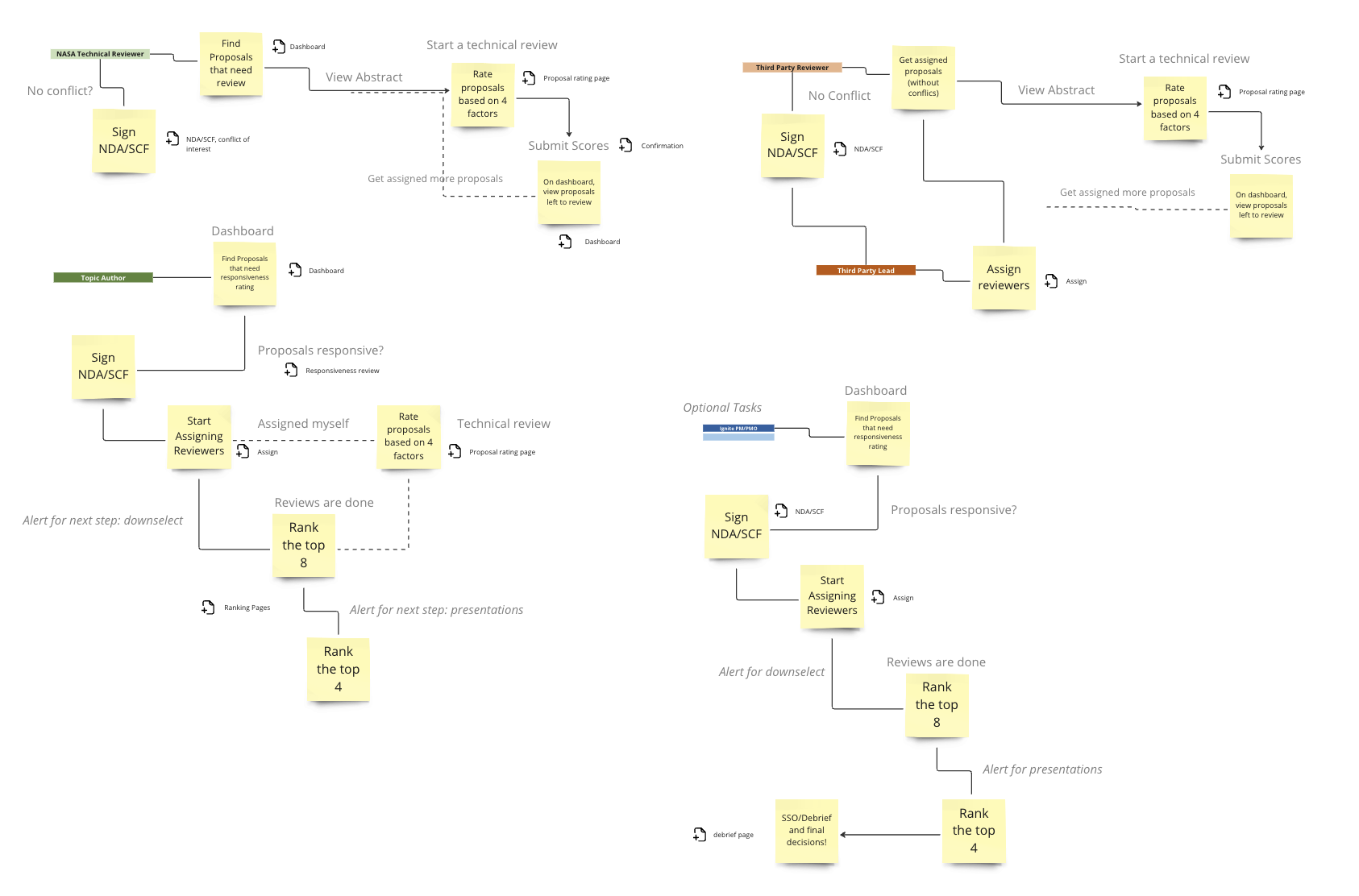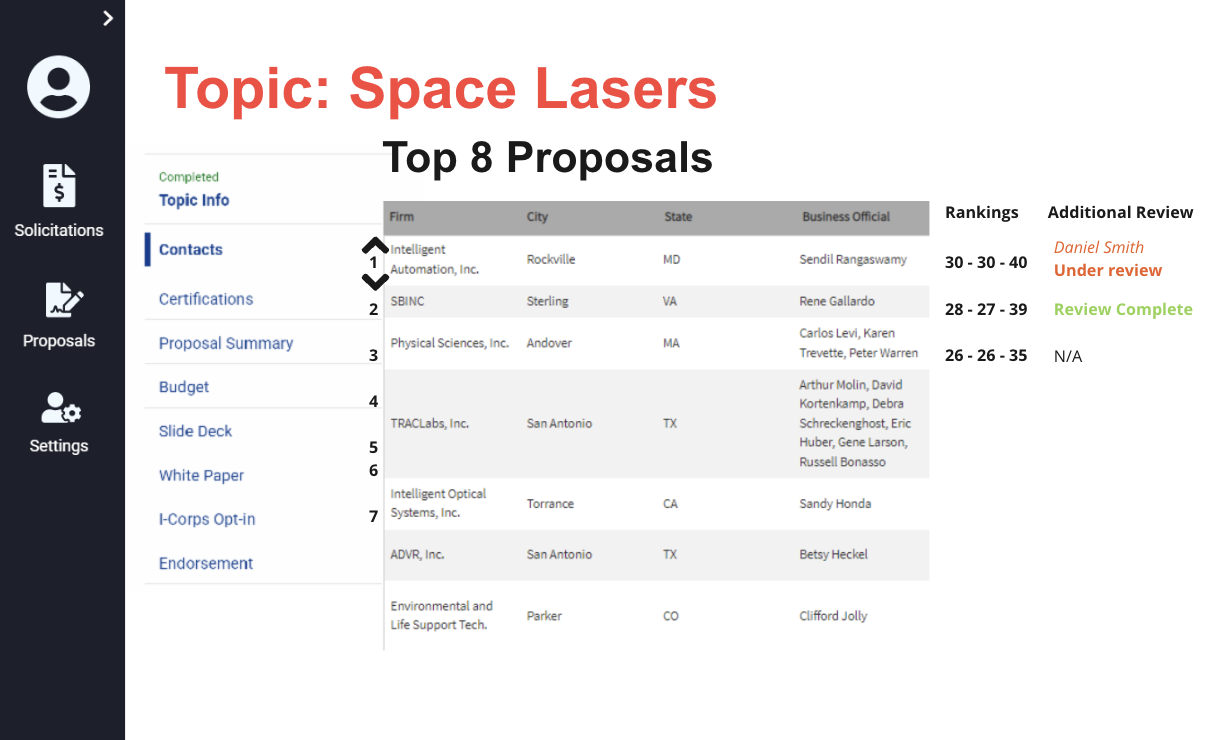
Modernizing NASA’s Contract Workflow Platform:
Transforming complex federal systems through human-centered design
NASA PETS (Platform Engineering and Technology Support Services)
Summary
I joined the ProSAMS redesign as a mid-level UX designer and became a key contributor on a complex government system modernization. Through user research, prototyping, and stakeholder engagement, I helped transform an outdated, paper-based workflow into a modern, user-friendly platform. The project was a turning point in my career, preparing me to lead UX efforts for large-scale systems.
My Role: UX Designer → Senior Contributor
Timeline: April 2023 – June 2025
Tools: Miro, Axure, Figma, MS Teams
Team: Cross-functional with 3 other UX Designers, Researchers, Business Analysts, and Project Managers
Project Overview
Client: NASA – Platform Engineering and Technology Support Services (PETS)
Product: ProSAMS – a proposal submission and contract management platform
ProSAMS connects innovative small businesses and researchers with NASA, enabling access to non-dilutive R&D funding. Unlike traditional funding platforms that require equity or proof of commercial viability, ProSAMS focuses on enabling early-stage innovation. The platform also acts as a technology marketplace for NASA program managers to discover, track, and transition promising technologies into practice.
The Challenge
NASA’s legacy system was complex, paper-based, and frustrating for both internal staff and external applicants. Key pain points included:
A lack of intuitive workflows
Redundant and inconsistent forms
Difficult navigation and minimal feedback loops
Poor communication between stakeholders due to system limitations
Our goal: Transform ProSAMS into a scalable, user-centered platform that supports R&D innovation while streamlining contract and proposal workflows across diverse user groups.
UX Goals
Simplify and modernize the contract and proposal submission experience - Empower small businesses and research institutions to deliver technological innovations that contribute to NASA’s missions, provide societal benefit, and grow the U.S. economy.
Reduce administrative burden by streamlining proposal submission and contract workflows
Improve platform accessibility and usability for diverse stakeholders (small businesses, NASA staff)
Enable better communication and task tracking through automated prompts and built-in feedback loops
Support NASA’s innovation mission by connecting researchers and small businesses with funding more efficiently
My Role and Growth
I joined as a UX Designer early in the discovery phase and quickly evolved into a lead contributor. My trajectory included:
Facilitated 20+ user interviews with internal and external users
Created detailed user flows, low- and high-fidelity prototypes using Miro, Figma, and Axure
Presented directly to NASA stakeholders across multiple design cycles
Owned end-to-end UX for key releases after senior team members transitioned off the project
Contributed to design decisions that improved onboarding time and reduced off-platform communication
This project transformed me from a designer-in-training to a strategic design leader capable of driving complex federal initiatives forward.
Research-Driven Design
Example Focus: Release 3 (R3)
Objective: Improve the SBIR/STTR Phase I contract negotiation process
We conducted deep-dive interviews with contracting officers at NASA to understand their workflow. Our questions explored communication habits, form usage, documentation protocols, and operational bottlenecks.
Key Findings:
Most communication happened outside the system due to usability issues
Contract documents were stored inconsistently
Users desired clearer feedback, pre-populated fields, and automated communications
Direct Feedback:
“Communications consistency would improve our workflow.”
“The system doesn’t help firms invoice properly—training and prompts would help.”
“Awarded contracts go back into the system, but the official file is saved elsewhere.”
Insights into Action
We turned pain points into tangible UX solutions:
Added auto-calculated due dates and pre-filled contract fields
Created separate views for contracts with/without TABA requests
Introduced prompts for incomplete forms
Clarified when responsibility forms are required during negotiation
These decisions were validated through iterative usability testing, improving both performance and user satisfaction.
Personas and User Flows
Persona and user flow development played a noteworthy role in understanding the target audience and informing design decisions throughout the project. Following user interviews distinct personas were created to represent key user types, ensuring that their needs and habits were accurately documented and addressed. This process helped align the discovery team’s approach with real user expectations, ultimately leading to a more effective solution.
Design Process
Low-Fidelity (Miro): Collaborated with Business Analysts to quickly sketch flows and ideas
High-Fidelity (Axure → Figma): Developed prototypes used in user testing and stakeholder demos
Design Evolution: Replaced dense, outdated forms with clean interfaces, visual hierarchy, and contextual guidance
Design Improvements: Then vs. Now
A side-by-side comparison of the original system and the redesigned page.
Final Impact
Directed UX enhancements for NASA’s Discovery Team, achieving a 90% improvement in average system performance during the transition from EHB to ProSAMS (new system). Redesigned workflows and eliminated manual submissions for NASA’s proposal systems, resulting in an 88% reduction in non-responsive firm proposals. Contributed to over $1.99M in cost savings by improving interface usability, system architecture, and maintainability.
Reduced reliance on off-platform communications (email/Excel)
Increased stakeholder trust through clear, iterative solutions
Reduced paperwork complexity through dynamic fields and form automation
Supported accessibility efforts with intuitive design
Informed naming and branding direction through user feedback
My UX Journey
This project was pivotal in shaping me into the designer I am today. I went from learning the ropes to owning high-impact design work for a critical government platform.
Leadership: Took initiative as team dynamics changed, stepped into lead roles with confidence
Mastery: Became fluent in Figma, user research, prototyping, and stakeholder communication
Collaboration: Worked with one of the most talented, supportive design teams I’ve ever experienced
Drive: Relentlessly pursued solutions that simplify complexity and bring clarity to mission-critical workflows
What I can offer as a UX leader:
Deep understanding of user needs in complex systems
Proven ability to translate insights into actionable, scalable solutions
Confident in owning cross-functional collaboration and presenting to executives
Driven by empathy, clarity, and impact
I’m ready to lead the next challenge—with curiosity, craft, and conviction.
Usability Testing
Interactive Axure and Figma prototypes were tested with both internal NASA staff and external applicants. These sessions provided real-time, actionable feedback that we quickly integrated into the design.
Feedback Highlights:
“I feel like you’re holding my hand through the process—which is exactly what I need as a new SBIR applicant.”
Users requested additional context and feedback, like file sizes on uploaded documents, submission date, time, and tracking number on final submission page and descriptions of roles and user permissions for assigned contact roles.
These insights led to meaningful adjustments across language, navigation, and labeling—creating a more confident user experience.
Design Documentation
I helped develop design documentation to align with the established design system and ensure consistency. This documentation served as a key resource for design standards.













